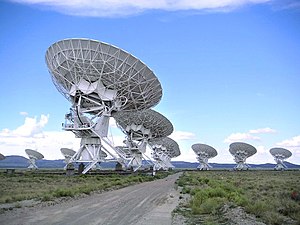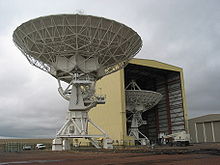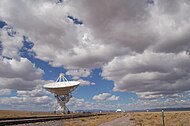Very Large Array
 | |
| Alternative names | VLA |
|---|---|
| Named after | Karl Guthe Jansky |
| Part of | NRAO VLA Sky Survey |
| Location(s) | Socorro County, New Mexico |
| Coordinates | 34°04′43.497″N 107°37′05.819″W / 34.07874917°N 107.61828306°W[1] |
| Organization | National Radio Astronomy Observatory |
| Altitude | 2,124 m (6,969 ft) |
| Wavelength | radio, 0.6–410 cm (50 GHz–73 MHz) |
| Built | 1973–1980 |
| Telescope style | Interferometer |
| Diameter | 27× 25m |
| Angular resolution | 0.05 to 700 arcsec |
| Collecting area | 9 m (f/0.36) |
| Website | science.nrao.edu/facilities/vla |
| | |
The Karl G. Jansky Very Large Array (VLA) is a radio astronomy observatory located on the Plains of San Agustin, between the towns of Magdalena and Datil, some 50 miles (80 km) west of Socorro, New Mexico, USA. Astronomers using the VLA have made key observations of black holes and protoplanetary disks around young stars, discovered magnetic filaments and traced complex gas motions at the Milky Way's center, probed the Universe's cosmological parameters, and provided new knowledge about the physical mechanisms that produce radio emission.
The VLA stands at an elevation of 6970 ft (2124 m) above sea level. It is a component of the National Radio Astronomy Observatory (NRAO).[2]
U.S. Route 60 passes through the complex, which is adjacent to the Boy Scout Double H High Adventure Base.
Characteristics

The observatory consists of 27 independent antennae, each of which has a dish diameter of 25 meters (82 feet) and weighs 209 metric tons (230 Short tons).[3] Each antenna is found along the three arms of a track, shaped in a wye (or Y) -configuration, (each of which measures 21 km/13 miles long). Using the rail tracks that follow each of these arms—and that, at one point, intersect with U.S. Route 60 at a level crossing—and a specially designed lifting locomotive ("Hein's Trein" [4]), the antennas can be physically relocated to a number of prepared positions, allowing aperture synthesis interferometry with a maximum baseline of 36 km (22 mi): in essence, the array acts as a single antenna with that diameter. The smallest angular resolution that can be reached is about 0.05 arcseconds at a wavelength of 7 mm.[1]
There are four commonly used configurations, designated A (the largest) through D (the tightest, when all the dishes are within 600 m of the center point). The observatory normally cycles through all the various possible configurations (including several hybrids) every 16 months; the antennas are moved every three to four months. Moves to smaller configurations are done in two stages, first shortening the east and west arms and later shortening the north arm. This allows for a short period of improved imaging of extremely northerly or southerly sources.[5]
The frequency coverage is 74 MHz to 50 GHz (400 to 0.7 cm).[6]
The Array Operations Center (AOC) for the VLA is located on the campus of the New Mexico Institute of Mining and Technology in Socorro, New Mexico. The AOC also currently serves as the control center for the Very Long Baseline Array (VLBA), a VLBI array of ten 25-meter dishes located from Hawaii in the west to the U.S. Virgin Islands in the east that constitutes the world's largest dedicated, full-time astronomical instrument.[7]
Upgrade and renaming


In 2011, a decade long upgrade project had resulted in the VLA expanding its technical capacities by factors of as much as 8,000. The 1970s era electronics were replaced with state-of-the-art equipment. To reflect this increased capacity, VLA officials asked for input from both the scientific community and the public in coming up with a new name for the array, and in January 2012 it was announced that the array would be renamed the "Karl G. Jansky Very Large Array".[8][9][10] On March 31, 2012 the VLA was officially renamed in a ceremony inside the Antenna Assembly Building.[11]
Key science
The VLA is a multi-purpose instrument designed to allow investigations of many astronomical objects, including radio galaxies, quasars, pulsars, supernova remnants, gamma ray bursts, radio-emitting stars, the sun and planets, astrophysical masers, black holes, and the hydrogen gas that constitutes a large portion of the Milky Way galaxy as well as external galaxies. In 1989 the VLA was used to receive radio communications from the Voyager 2 spacecraft as it flew by Neptune. It is not, despite depictions in popular culture, used to assist in the Search for Extra-Terrestrial Intelligence (SETI).
Past and future
The driving force for the development of the VLA was David S. Heeschen. He is noted as having "sustained and guided the development of the best radio astronomy observatory in the world for sixteen years."[12] Congressional approval for the VLA project was given in August 1972, and construction began some six months later. The first antenna was put into place in September 1975 and the complex was formally inaugurated in 1980, after a total investment of USD $78.5 million.[1] It was the largest configuration of radio telescopes in the world.
With a view to upgrading the venerable 1970s technology with which the VLA was built, the VLA has evolved into the Expanded Very Large Array (EVLA). The upgrade has enhanced the instrument's sensitivity, frequency range, and resolution with the installation of new hardware at the San Agustin site. A second phase of this upgrade may add up to eight additional dishes in other parts of the state of New Mexico, up to 300 km away, if funded.[13]
In popular culture
The image of the VLA has become nearly iconic in American culture, though most persons do not know where it is located or what exactly it does. But it has appeared repeatedly in pop culture since its construction.
- The VLA is the setting for the beginning of the 1984 film 2010. Here the Soviet scientist Dmitri Moiseyevich meets with Dr Heywood Floyd to suggest a joint mission to Jupiter.
- For the 1997 film Contact, much of the outdoor footage was shot at the VLA site with the number of dishes visible on screen artificially increased by CGI, and the canyon depicted as being in the vicinity of the VLA is actually Canyon de Chelly in neighboring Arizona.
- In the 2009 science-fiction film Terminator Salvation, the VLA is the location of a Skynet facility. At the beginning of the film the site is attacked by Resistance forces.
- New Jersey rock band Bon Jovi shot the music video for "Everyday", at the VLA and a "dish" can be seen on the cover of the album Bounce. Likewise Matt Harding can be seen dancing at this location in his second video.
- The cover for the Night Ranger album Dawn Patrol, the Dire Straits album On The Night, and the At the Drive-In album In/Casino/Out feature the VLA.
- The VLA featured prominently in Carl Sagan's 1980 documentary Cosmos: A Personal Voyage.
- The VLA features in plans to save the world from satellites being pulled from orbit in the second volume of the comic book series G.I. Joe: America's Elite published by Devil's Due.
- The VLA could be visited in Auto Assault, a massively multiplayer online game that was set in post-apocalyptic America.
- In the British Broadcasting Corporation series Luther, Alice Morgan states that she has always wanted to visit the VLA.
- The VLA appears at the beginning of the movie Transformers: Dark of the moon, incorrectly shown as existing before it was actually constructed.
- It also appears in an episode of Transformers: Prime, when the Decepticons intend to use it to help aim a long-range teleporter to Cybertron.
- In Arthur C. Clarke's novel, Imperial Earth, the male protagonist's estranged bisexual male lover is killed when one of the VLA telescopes' elevation gear suddenly activates.
- The VLA appears on the cover of two albums by the ambient musical group, Carbon Based Lifeforms.
Visiting
The VLA is located between the towns of Magdalena and Datil, about 50 miles (80 km) west of Socorro, New Mexico. U.S. Route 60 passes east-west through the complex.
The VLA site is open to visitors year round during daylight hours, and on every first Saturday of the month, special guided and behind-the-scenes tours are offered. A visitor center houses a small museum, theater, and a gift shop. A self-guided walking tour is available, as the visitor center is not staffed continuously. Visitors unfamiliar with the area are warned that there is little food on site, or in the sparsely populated surroundings; those unfamiliar with the high desert are warned that the weather is quite variable, and can remain cold into April.[2] For those who cannot travel to the site, the NRAO created a virtual tour of the VLA called the VLA Explorer.
Gallery
-
Very Large Array dish to scale—note person at left of base
-
The Very Large Array as seen from space
-
Detail of one dish
-
An antenna deployed at the VLA
See also
- Very Long Baseline Array
- Very Long Baseline Interferometry
- Atacama Large Millimeter Array a.k.a. ALMA
- List of radio telescopes
- The Very Small Array
- The VLA was once used for following up the Wow! signal from the SETI project
- British artist Keith Tyson made an epic 300 piece sculpture called 'Large Field Array' named after the VLA
- Magdalena Ridge Observatory is a new observatory under construction a few miles South of the VLA includes an optical Interferometer and is also run by VLA collaborator New Mexico Tech
- The Square Kilometre Array
References
- ^ a b c An Overview of the Very Large Array
- ^ a b Touring the VLA
- ^ VLA
- ^ Hein's Trein article
- ^ VLA configurations[dead link]
- ^ [1], VLA Overview
- ^ VLBA
- ^ [2]
- ^ [3]
- ^ http://www.nrao.edu/pr/2012/jansky/
- ^ http://www.nrao.edu/pr/2012/rededicate/
- ^ The Cosmic Inquirers by Wallace and Karen Tucker
- ^ The Expanded VLA project





